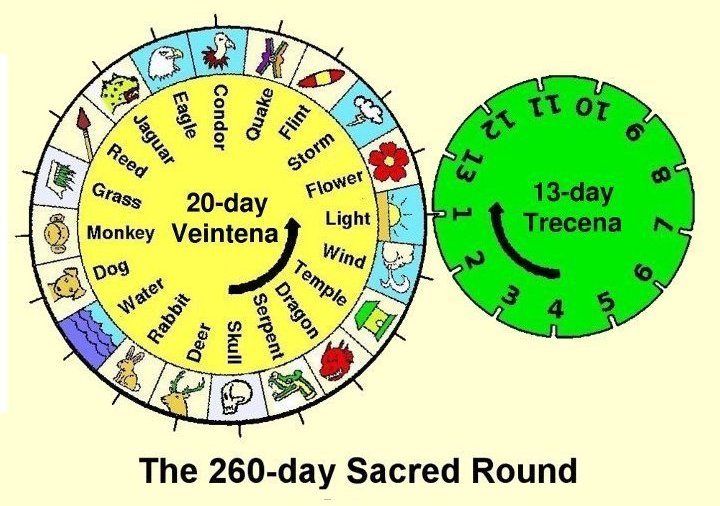
by John P. Pratt
14 Aug 2019, 1 Birth (UV)
©2019 by John P. Pratt. All rights Reserved.
|
1. Bundling Years 2. Earth and Venus 2.1 Venus & Egyptian Calendar 2.2 Toltecs and Venturies 2.3 Clock Hands 2.4 Double Cycles 3. The Toltec Ventury Calendar 3.1 Evening & Morning Star 3.2 Long-Term Correction 3.3 Mayan Correlation 4. Witness of Sacred Events 4.1 REED Age (4070 BC-2731 BC) 4.2 RABBIT Age (2730 BC-1395 BC) 4.3 TEMPLE Age (1394 BC-56 BC) 4.4 FLINT Age (55 BC-1283) 4.5 ARROW Age (1284-2622) 5. Conclusion Notes |
Recently a model of the Toltec Calendar was proposed based on its description and use in an Aztec history.[1] It was shown to qualify as a sacred calendar used by the Lord in timing sacred events. Because most sacred calendars have a "uniform" counterpart which never inserts leap days, it was decided to determine whether or not there was also a Uniform Toltec Calendar. Moreover, it is known that the Mayans used a straight 365-day year and it was linked in a known way to the 260-day Sacred Round Calendar. Thus, that 365-day calendar was researched to see if it might qualify as a sacred calendar.
It was found that such a calendar could indeed qualify, but years would be bundled together in such an unusual fashion, not employed by any other known sacred calendar, that it actually merited its own name. The Aztec history made it clear that years were not only grouped into 52-year rounds, but that the earlier Toltecs also had a unit of time comprising two rounds, which is surprising. The 104-year period was translated "ventury", being a contraction of "Venus century", because it was about one hundred years and its length was equal to the time of Venus making almost exactly 65 risings of Venus as the Evening Star.
That sort of bundling of a calendar with fixed length cycles to have its cycles grouped according to another celestial body is unprecedented in known sacred calendars. Nevertheless, research vindicates the practice and shows that the length of the Venus Cycle is such that corrections can be made to use it throughout history and counting by venturies in a manner consistent with the overall pattern of the calendar.
This article first describes the details of the proposed calendar in Sections 1-3 and then gives examples of its possible use in Section 4. An attempt has been made to allow the reader to skip directly to Section 4 if desired.
 |
Sometimes a related calendar is used to help bundle the years of a sacred calendar. An example of that was given in the recent article about the the Toltec Calendar. It has a 365-day year composed of months and days. When it came time to look for a grouping system, such as a Great Year comprising 365-years in the manner of other sacred calendars, such a scheme was not even considered because the Aztecs had preserved the Toltec system, and it was clear that God was using that system. That system was to bundle the years into "rounds" of 52 years, each with a unique name taken from the related Sacred Round Calendar. These 52 years were subdivided into groups of 13 consecutive years, one beginning with the year named 1 FLINT (names in all capitals refer to years or bundles of years rather than days), the next 13 with 1 TEMPLE, the next with 1 RABBIT, and the last with 1 REED. The names of the other years had the numbers 2-13 associated with those same four names (signs), yielding 52 unique names.
That still left the problem of how to identify which 52-year round was being referred to, which knowledge the Aztecs had lost or never learned. In the case of the Toltec Calendar, again the Sacred Round was useful because each of the 20 day signs could easily be used to identify and even describe each round. The point here is that that in every sacred calendar known to me until now, the grouping method for years does not involve tracking another other celestial object, but only some form of counting. As will now be discussed, the Toltec Ventury Calendar adds a whole new dimension to sacred calendars.
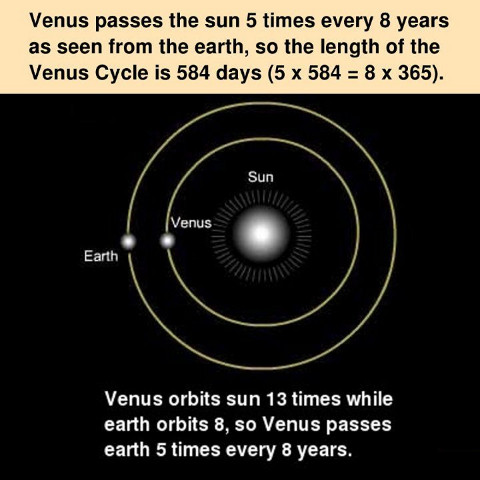 |
To show how accurate the alignment is, the length of the Venus Cycle is 583.92166 days on average, which is nearly 584 days. Mathematically, 5 x 584 = 8 x 365 = 2,920 days, so it is very close. Let us see just how that fact has been noticed before in ancient calendars.
The ancient Egyptians had a 365-day calendar. They did not insert leap days every four years to make the average 365.25 which is much closer to the true length of the year. How noticeable would that omission of leap days be? One day every four years would add up to 15 days in 60 years and 30 days in 120 years. So in only a century, people would notice that the flooding of the Nile was coming an entire month late and in two centuries it would be nearly two months late! They had a long lasting civilization, but after two thousands years, in the time of the Greeks about 300 BC they had still not decided to add any leap days, but instead watched the flooding of the Nile come in different months going all through the year. Why?
Some historians have searched out the answer to this question and it turns out that they were aware of the relationship of the 365-day year to Venus, one of their important goddesses. They knew that if 1 leap day were added every four years, then after 5 Venus cycles, the year would be two days off (the very two leap days added)! Apparently there were big debates about this until finally the Venus worshippers lost. Leap days were commanded by the Decree of Canopus in 238 BC, but the outcry was so great that the practice was not implemented until commanded by Augustus Caesar in 22 BC![2]
Where did they learn about Earth and Venus orbital relationships? Did Abraham teach them? After all, he was commanded to go teach the Egyptians what he had learned from God about the various orbital periods, as viewed from the earth (Abr. 3:15). Could it be that there is something very sacred to know about the use of a straight 365-day calendar? Notice especially they were not concerned about grouping the years in any special way, but only in tracking Venus with what looks like a calendar for tracking the earth's year.
There are two big clues that the Toltecs were using Venus somehow to bundle the years. Let's look at each to see if there is a way that it looks like the solar system was created in a way that allows such to fit into their patterns.
First, the Aztec history refers to a unit of time of two sets of 52-year rounds. Why would they need a special word for two rounds? In the translation into English provided in my recent article, a special word was coined for that unit: the "ventury", short for "Venus century". The history explicitly defines this unit to equal two rounds (Ixt. 2:38). When a special word is coined for a unit of time, there is always a reason.
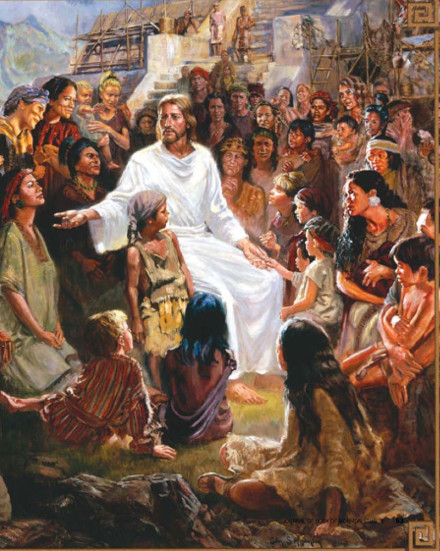 |
That researcher proposed that the tie to Venus is the following. As shown in Figure 1 and discussed above, Venus crosses between Earth and Sun five times in 8 years. In 52 years it crosses 32.5 times, but in 2 rounds (104 = 13x8 years) it crosses 65 (13x5) times, almost exactly. Thus, it appears the Toltecs would have understood that 5 "full cycles" of Venus would refer to 104 years for each, with 5 such full cycles being 520 years.
So here we have two different accounts of a 365-day year calendar being tied to the cycles of Venus. The Egyptians tied it only to the 8-year cycle, but the Toltecs tied it 13 sets of 8-year cycles or 104 years, being exactly 2 rounds on their calendar.
All of this is interpreted to mean that the ventury of 104 365-day years should be strongly considered as a way to bundle rounds into larger units of time.
 |
We all know that the reason for more hands is to time intervals of different lengths to different accuracies. The hour hand is for longer intervals than seconds or minutes, but if only approximate accuracy is needed, then the sundial's one hand may suffice. When I was young I envisioned making a sundial very large so that it could be read to the very second! Little did I know before studying physics that the sun cannot cast a shadow to be read much more closely than a minute. So we have clocks with three hands to cover most cases. But even that won't work well to measure several years.
Recently, it has become clear that sacred calendars work in the same manner. There are second hands which read to the very day, minute hands which read to the year, and larger periods, like the century and ventury, which are designed to give approximate dates in longer periods of time. We can speak of events of the Fifteenth Century referring the general time period, where it would actually be confusing to be accurate to the year. Another example is that it is usually easy to tell if someone has a digital or analog watch because one will say, "It's 8:47," and the other will say, "It's ten to nine." In fact, many watches do not even have numbers for the hands but only markers at the 15-minute places. That is considered close enough for most uses.
In my sacred calendar research until now, the work has been focused on holy days and sometimes a few holy years, but holy centuries have not even been considered. Thus when attempting to determine a correct model for a Uniform Toltec Calendar, I spent several days analyzing several possible starting points for it. None of them produced the usual number of holy days aligning with sacred events as with other sacred calendars. Then the big aha moment came! The other sacred calendars have no real provision for large units of time, whereas the Toltec Calendar has names for every 52-year round, and then packages them into four named world Ages. It is clearly designed to work for long periods of time like an hour hand. It works in tandem with other calendars, as it does with the Sacred Round, which are designed to highlight individual days. It has some holy days, but fewer than other sacred calendars.
The hour hand concept is even more true of the Uniform Toltec Calendar, so named because it never inserts leap days to keep the beginning of the year in the spring. It is unique among the sacred calendars known so far. In fact, it is so different that the proposed name is the Toltec Ventury (TV) Calendar because it differs significantly from the Toltec Calendar in long term grouping. It makes no attempt to be accurate in the length of the year, but instead apparently assumes that an approximate year (within 5 years throughout history) is good enough. In exchange for giving that precision, it also keeps track of the approximate cycles of Venus! It is two long term calendars in one, which turns out to be a useful trade-off in exchange for giving up precise short term dates. It can still highlight a few precise dates, but not as many. In fact, when used together with a short-term calendar (Sacred Round), then nothing is lost at all, like two hands on a clock!
How many hours are there in a day? (Please actually give an answer!)
...
Time is up! Did you say 12? Or are you sure the answer is 24? Why do we use the word "day" for both periods of time? One definition of day refers to the period of daylight, with another word ("night") referring to the dark period. The other definition of day is time from noon to noon and is twice as long.
There are other places in time keeping where a double cycle is used. Why are double cycles used and even given special names? To me the answer is that the double unit is actually measuring another cycle which is twice as long. In fact, the longer cycle may be the actual unit which is being measured. The day is a great example. The two words "day" and "night" are very important in our lives (John 11:9-10), but the full daily cycle of the earth is the 24-hour day, and that is every bit as important.
Now let us see how all of these concepts are combined in yet another amazing sacred calendar.
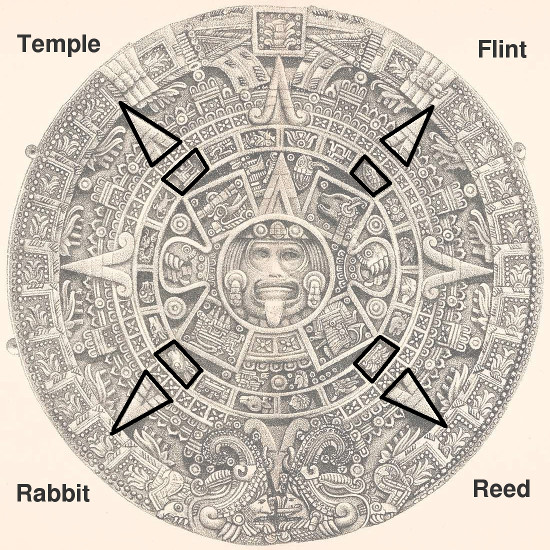 |
As far as holy days are concerned, whereas most of the holy days are taken straight from the Enoch and Hebrew day numbering, a question arises about the day 0.I. The day 1.I would be the major holy day New Year, the first day of a new year. But what about 0.I? Is that a holy day? The Jubilee Calendar can be the role model in this case. The first and last days of the year about both major holy days. The last day is called the Great Day (short for Great and Last Day as in John 7:37), and it is a major holy day. Thus, it is proposed here that the day 0.I is a major holy day called Great Day.
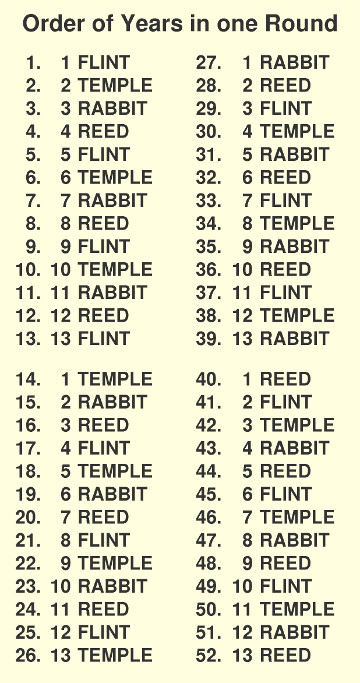 |
Like the Aztec Calendar, the years are named for the first day of the year. That results in 52 possible year names, being the numbers 1 to 13 followed by one of the four glyphs FLINT, TEMPLE, RABBIT, and REED (names are capitalized when they refer to the longer of two time units with the same name). The years, however, rotate through the names like this: 1 FLINT, 2 TEMPLE, 3 RABBIT, 4 REED, 5 FLINT, and so on. This results in four divisions of a 52-year round: 13 years beginning with 1 FLINT, then 13 more starting with 1 TEMPLE, and so forth (see Table 1).
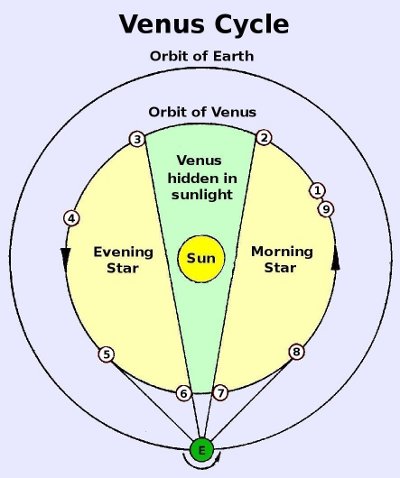 |
The planet Venus spends equal time (nine months) as Evening Star and as Morning Star (see Figure 3). As for the fact that 104 years is two rounds, that fits perfectly with the fact that the length of the Venus Cycle is 1.6 years, so usually the Evening Star phase begins in one year and the Morning Star Phase begins in the next. The phase of Venus is exactly half a cycle different in the first year of any two consecutive rounds, because a round is 32.5 Venus Cycles. If the alignment of the Venus cycle is judiciously chosen and corrected for the long term when necessary, then the 9 month-long Evening Star phase will always begin with its birth on 1 Birth (V) in the first year of the two rounds of a ventury and the Morning Star phase will always begin with 1 Resurrection (V) in the first year of the second round.
In that manner, the two rounds of a ventury can be identified with an "E" (Evening) for the first and "M" (Morning) for the second. It is exactly analogous to the use of the ancient use of 12 hours of the night and 12 hours of the day, and similar to the modern use of a.m. and p.m. to distinguish between the two sets of 12 hours in each full 24-hour day.
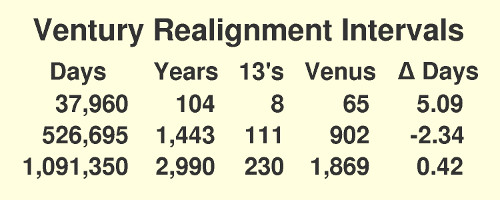 |
With that in mind, the proposed calendar counts 13 venturies and then skips the last 13 years of the last ventury to make the needed long term correction. If the first Age begins in a year 1 REED, then the next Age will begin on 1 RABBIT because of the 13 years skipped. Each Age can be named after the day sign of the first year (like REED), with each ventury simply numbered in order: 1 REED, 2 REED, 3 REED, etc.
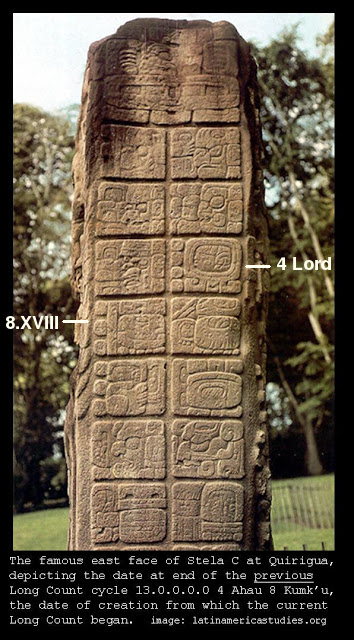 |
The Mayan Calendar combined three different calendars. They used the 260-day Sacred Round, the 365-day calendar with no leap days, and what is called the Long Count. They did not use the system of grouping the 365-day years into rounds like the Toltecs, but instead devised the Long Count which simply counts the 20 day signs indefinitely.
The Mayan, Toltec and Aztec calendar systems clearly all had a common origin based on the Sacred Round. My research has verified that their Sacred Round dates were correct, meaning that God is using that calendar. All of the 365-day calendar dates engraved on stone along with Sacred Round dates use the same correlation of those two calendars with each other. That correlation is the natural starting point to use for the TV Calendar because it needs to relate the two calendars. That is, the first day (1.I) of the year 1 FLINT (TV) must fall on the day 1 Flint (SR). Figure 4 gives an example of a Mayan stone stela with a date which shows that 4 Lord (SR) fell on 8.XVIII of that 365-day year, that is, on the 8th day of the eighteenth 20-day month.
Given the above model, when the Mayan correlation was used for the TV Calendar, it worked so well that it has been chosen to be used in my proposed model. About twenty other possibilities were tried which mostly gave random results. That was determined by looking at years and venturies as well as holy days, because this calendar is for the long term.
Using that correlation[5], the beginning date of the TV Calendar is in the very birth year of Adam! His birth date was Sat 17 Oct 4070 BC, which was the day 1 Birth (V) and near the middle of the year 1 REED (3.VII, TV). Here we see how the "hour", "minute", and "second" hands of the celestial clock work. The day 1 Birth (V) is the exact day of the birth of Venus, beginning its Evening Star phase. The year 1 REED is like the minute hand, being a major holy year. Moreover, this year was the first year of a ventury of 104 years, named 1 REED, which is the hour hand. In fact, that year begins an entire Age of 1,339 years! The reader can see that this one date alone is compelling that the correlation to our Gregorian Calendar is correct! Many others will be discussed in Section 4.
This correlation leads to the 1339-year Ages to begin with a year 1 REED in 4070 BC. The first 13 venturies can be identified as 1 REED, 2 REED, 3 REED, etc. Note they are all named REED, not cycling through all four signs as do the year names. This Age can be named simply REED because every ventury starts in a year 1 REED. The second age will be RABBIT because all thirteen venturies start in a year named 1 RABBIT. Note that the rotation of Age names goes backwards (from REED to RABBIT, not TEMPLE) because the last thirteen years were skipped. The third Age is TEMPLE and the fourth is FLINT. We are currently in the fifth and final age called ARROW, which is Mixtec sign for REED used in my work. Because the first and last Age both start on 1 REED, two different names are used to distinguish them.
Holy years and venturies can be defined the same as are days: those with numbers 1, 7, or 13 are at least minor holy, and those with number 1 or 13 and names TEMPLE or REED (ARROW) are major holy. Major holy periods are in boldface italics and minor in italics.
Now let us look at several alignments of holy days, holy years, and holy venturies with known sacred events throughout history. As we do so, keep in mind there will only be a few holy days mentioned because the main use of this calendar is to track longer periods like years and rounds during which many sacred events occurred. Dates of sacred events not given can be found on my Religious Chronology which provides references to how they were derived.
The REED Age proposed in the TV Calendar began with the birth of Adam on 1 Birth (V) in the year 1 REED (TV), which year also began the REED Age with the 1 REED ventury, both named for that year. That birth date of Sat 17 Oct 4070 BC, published 16 years ago, is in a TV year in which the first day of the first month was 1 Reed (SR). What is impressive about this alignment to the very day is that it was obtained by using the Mayan correlation of the 365-day calendar to the Sacred Round, as explained above.
Beginning of Mortality. The day on which Adam and Eve left the Garden of Eden on Sun 9 Apr 4001 BC was holy on most of the sacred calendars and the TV Calendar is no exception. The day was the holy day Consecration (10.I, TV), the day on which the sacrificial lamb was chosen for Passover. On other calendars the day was Passover, such as the Perpetual Hebrew (PH) and Jubilee (J) Calendars. It was also End Passover on the Toltec (T) Calendar.
Death of Adam. Adam lived over 999 years, reckoning from his birth, which would put his death in the round named 10 REED M, the "M" meaning the Morning Star (second) round of the tenth 104-year ventury counting that of his birth in 1 REED E ("E" for Evening Star round, the first of two 52-year rounds in a ventury). The name of the year in which he died was the major holy year 13 REED.
Death of Seth. The very day proposed long ago for the death of Adam's son Seth falls on the major holy day which represents death: End Tabernacles (21.VII, TV). For comparison, Adam died on End Tabernacles (22 Tishri, PH). That is a bull's-eye.
The Great Flood. The Aztec history gives the very year of the Creation as 1 FLINT and implies the year of the Great Deluge was either 13 REED or the next year 1 FLINT because he states that 1,716 years (33 rounds of 52 years) after that came the destruction of mankind by a flood which "covered everything in the earth" (Ixt. 3:9). That is another bull's-eye because on the TV Calendar, the Flood began in the year 13 REED and ended in the year 1 FLINT when the ark first rested in their new home. Even that transition between years seems meaningful because 13 REED, the last year of a round did indeed represent the end of the former world and 1 FLINT, the first year of the next round was indeed a new beginning![6]
Birth of Isaac. The birth of Isaac was on a holy day in a holy year which began a round! It is another example, along with the birth of Adam, of how the hands on the celestial clock work. Isaac's birth on Tue 16 Mar 1952 BC was 1 Resurrection (V), the very first day of a Morning Star phase of Venus. That day was in the year 1 RABBIT, which was the holy first year of the 52-year round named 8 RABBIT M (TV). That is, it began the second round of the ventury 8 RABBIT, during which year the day 1 Res (V) would occur begin the Morning Star (M) phase of Venus. That happened on the very day of his birth! That is the second hand (day), minute hand (year) and hour hand (round) all lining up precisely.
Hopefully it is clear to the reader that such multiple alignments are not possible for all of the births of patriarchs like Abraham, Isaac, Jacob, and Joseph because they can only occur on 1 day in 52 years! But it is compelling when several do line up on the very day indicated. Moreover, both the T and TV calendars do not seem to be used much for births, but more for events. For example, the day on which the Lord and Isaac made a covenant on Sat 20 Sep 1874 BC was in the year 1 FLINT (TV).
The Exodus. The children of Israel were led out of the bondage of Egypt and into the Promised Land during the holy ventury 13 RABBIT. Moses led them out of Egypt during the Evening Star half (13 RABBIT E) and Joshua led them into Canaan in the Morning Star half (13 RABBIT M). Previous articles have detailed how many of the events of 40 years in the wilderness were tied to the Venus Calendar, such as the entire 40 years being a cycle from the Parting of the Red Sea and manna ceasing both on 1 Birth (V). Moreover, Joshua and Miriam were both born on 1 Birth (V).
Crossing the Jordan. The day on which the waters of the Jordan River parted to let the Israelites enter the Promised Land was holy on many calendars including the Toltec (Consecration, 10.I) and Toltec Ventury (1.X) calendars.
Dedication of Solomon's Temple. The final day of the dedication of the Temple of Solomon (Fri 2 Oct 972 BC) was another perfect hit. It occurred on the same major holy day, Atonement, on both the T and TV calendars. It was also a holy year on both calendars even though the years were different (7 TEMPLE, T) and (7 REED, TV). Finally, it also occurred during the TEMPLE Age.
Jeremiah's Ministry. The date of the beginning of Jeremiah's ministry on Thu 4 Aug 627 BC has been in my database for years, but may never have been published in my work because it was not on many holy days. But now it is seen to be in the holy years 1 RABBIT (T) and 1 FLINT (TV). His mission lasted forty years in Jerusalem, until its fall, and then continued on for several years where he went to build and to plant after having pulled down and destroyed (Jer. 1:10). That makes his ministry a perfect candidate to last for an entire 52-year round!
Lehi's Departure. The date of Lehi leaving Jerusalem was a huge date on the Toltec Calendar, being in the beginning year of an entire Age of 1,716 years. Now, it is also seen to been on the holy day Raven Day in the holy year 1 RABBIT (TV). That seems significant that it was holy on both calendars associated with the Americas.
Ezra's Commission. The day on which Ezra the Scribe left to return to Jerusalem to head the project of rebuilding the temple was on 1 Reed (SR) and Passover in the year 1 REED (14.I, T). Now it also turns out to have been in the year 1 TEMPLE (TV), which was the beginning year of the ventury 11 TEMPLE. Thus, it was a really important day on both calendars. It represented the beginning of the effort to rebuild the Temple of Solomon. Cyrus the Great had authorized the Jews to rebuild it some eighty years earlier, but not much happened due to interference from enemies and lack of funds. With Ezra, the commission to restart the building was renewed by Artaxerxes, King of Persia, complete with money from the treasury to support the project. Thus, this date represents the practical starting date of the temple restoration. This important date when Ezra began his journey to Jerusalem on New Year, 1 Nisan (PH) was Fri 2 Apr 458 BC (Ezra 7:9).
Meridian of Time. The birth of the Savior was just after the beginning of the holy round named 1 FLINT M during the first holy ventury of the FLINT Age. This round likely represented the "Meridian of Time" on the TV Calendar. It was also the round named LIGHT on the Toltec Calendar, both of which rounds began just two years before His birth. That early date allows the announcement of Gabriel to Zachariah to also be in both sacred rounds. Other sacred calendars had a holy period for the Meridian of Time, such a 49-year jubilee on the Jubilee Calendar (J), which exactly spanned the time from the birth of John the Baptist to the death of the Virgin Mary. These two rounds cover nearly the same period, but started two years earlier. The date of Mary's death was in the major holy year 13 REED (TV), the very last year of the Meridian of Time round.
That is my only entry during this age because there are no other dates in my database for this time period!
U.S. Constitution Approved. The date of Mon 17 Sep 1787 has been in my database for years as the date on which the delegates to the Constitution Convention approved the proposed U.S. Constitution. It had not been on any holy day worth noting, so it has not been mentioned in any articles so far. Now it turns out to have been on the two holy days Trumpets (1.VII, T) and Decision Day 2 (24.IV, TV) on the Toltec calendars. Both of those days seem significant, especially because those calendars deal with the western hemisphere. It was a day to blow the trumpets to herald to the world an improved form of republic. Moreover, it was a time of decision, not only to approve the constitution but to then invite the states to ratify it and even later to see if it would be followed. The signing of the Declaration of Independence on Thu 4 Jul 1776 was also a Decision Day (PH).
Church Restoration. The year 1803 began the ventury named 6 ARROW with its first year being 1 REED, which indeed did begin a new era in which the gospel of Jesus Christ would be restored in its fulness. The births of Emma and Joseph Smith occurred just one and two years later.
Birth of Sidney Rigdon. The official spokesman (D&C 100:9) for the Prophet Joseph Smith who had been prophesied by Joseph of Egypt (2 Nephi 3:18) was born on multiple holy days. His birth was also in the first year of a 52-year round on the Toltec calendar which ended with the martyrdom of Joseph and Hyrum Smith.
Now it is seen that his birthday was also on the major holy day Winter (TV) as well. That is significant because the Prophet Joseph was born on Winter (PH). The two men formed a pair of witnesses all during the Church presidency of Joseph Smith, Sidney being a counselor in that presidency. Moreover, the two birth dates also are a pair of witnesses to testify that the light of the gospel fulness would now be returning to the world.
Priesthood Restoration. Two key dates in the Restoration were the restoration of the lesser and greater priesthoods. The date proposed in my work for the restoration of the Aaronic Priesthood by John the Baptist is Sat 16 May 1829, which was the zeroth day of the major holy year 1 TEMPLE (0.I, TV). As mentioned earlier, that day is called the Great Day. Two weeks later, before 6 am on Sun 31 May 1829, the higher priesthood held by ordained apostles of Jesus Christ was restored by Peter, James and John on Passover in 1 TEMPLE (14.I, TV). That pair of witnesses, accurate to the very day, emphasize the importance of those two events.
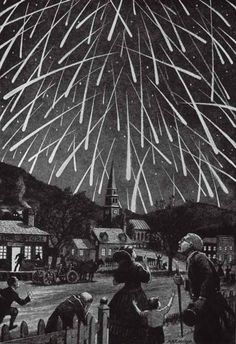 |
Night the Stars Fell. There was a key historical event which until now was not known to have occurred on a holy day on any known sacred calendar. On Wed 13 Nov 1833, what may have been the greatest meteor storm in history occurred. So many "stars" (meteors) fell that people could read a newspaper by the light and some were awakened by the flickering light in the middle of the night, thinking their homes were on fire. One account claimed that the Prophet Joseph had prophesied its occurrence as a sign of the last days.[7]
Now it is discovered that this event occurred on the Feast of Trumpets (1.VII, TV). That is not just any holy day, but one which perfectly matches the significance of that event. The scriptures testify that falling stars will herald the coming of the Savior along with the angels sounding the trumpet (Mat. 24:29-31). The Prophet Joseph explained that the sign given then was not as majestic as the one would be just before the Second Coming, but that it had similar significance. Again note that this event was seen all over the United States, but it was a sign only to the western hemisphere, where the TV Calendar especially applies.
David the Servant. The new name of "David" was given to David the Servant just nine days before the beginning of the ventury 8 ARROW. That ventury began with the birth of Venus as the Evening Star on Mon 19 Sep 2011 on 1 Birth (V). He has been tasked with being a shepherd to lead a covenant flock which had been scattered to a peaceful pasture to dwell safely the wilderness (Ezek. 34:22-25). That rising of the Evening Star began a ventury of 104 years which will include the building of the New Jerusalem, the return of the City of Enoch, and the Second Coming of Jesus Christ!
A model for a Toltec Ventury (TV) Calendar is proposed, based on the fixed 365-day year of the Toltecs and Mayans. It employs the same correlation to the 260-day Sacred Round as shown on engraved Mayan dates. Based on written accounts from Aztec history, as well as from the ancient Egyptian use of the 365-day year, the bundling of years is done in 104-year "venturies" (a contraction of "Venus centuries) in which Venus manifests as Evening Star in the first year of the first 52-year round and as Morning Star in the first year of the second. Thirteen of these venturies are grouped together to form one 1,339-year Age and five Ages cover most of history. This calendar was first expected to be called the Uniform Toltec Calendar, but its accurate tracking of Venus and different manner of bundling years into five Ages instead of four, seem to require a name linking it to Venus.
Evidence is then presented that many sacred events occur in the holy days, years and rounds of this calendar, qualifying it to be included in the list of sacred calendars. Two excellent examples are the birth of Adam and of Isaac which occurred on the very day of the birth and resurrection of Venus, respectively, to open a 52-year round. It was proposed that, like the Toltec Calendar, this calendar is used mostly to highlight years and rounds where many sacred events would occur.
It is also concluded that the Toltec and Toltec Ventury Calendars form a closely connected pair. The Toltec measures years precisely and venturies only approximately, whereas the TV Calendar tracks venturies precisely and years only approximately.
The intricate interaction of the TV Calendar with the Sacred Round and the Venus Cycle to highlight sacred events witnesses of its creation and use by the bright Morning Star himself (Rev. 22:16), even Jesus Christ.